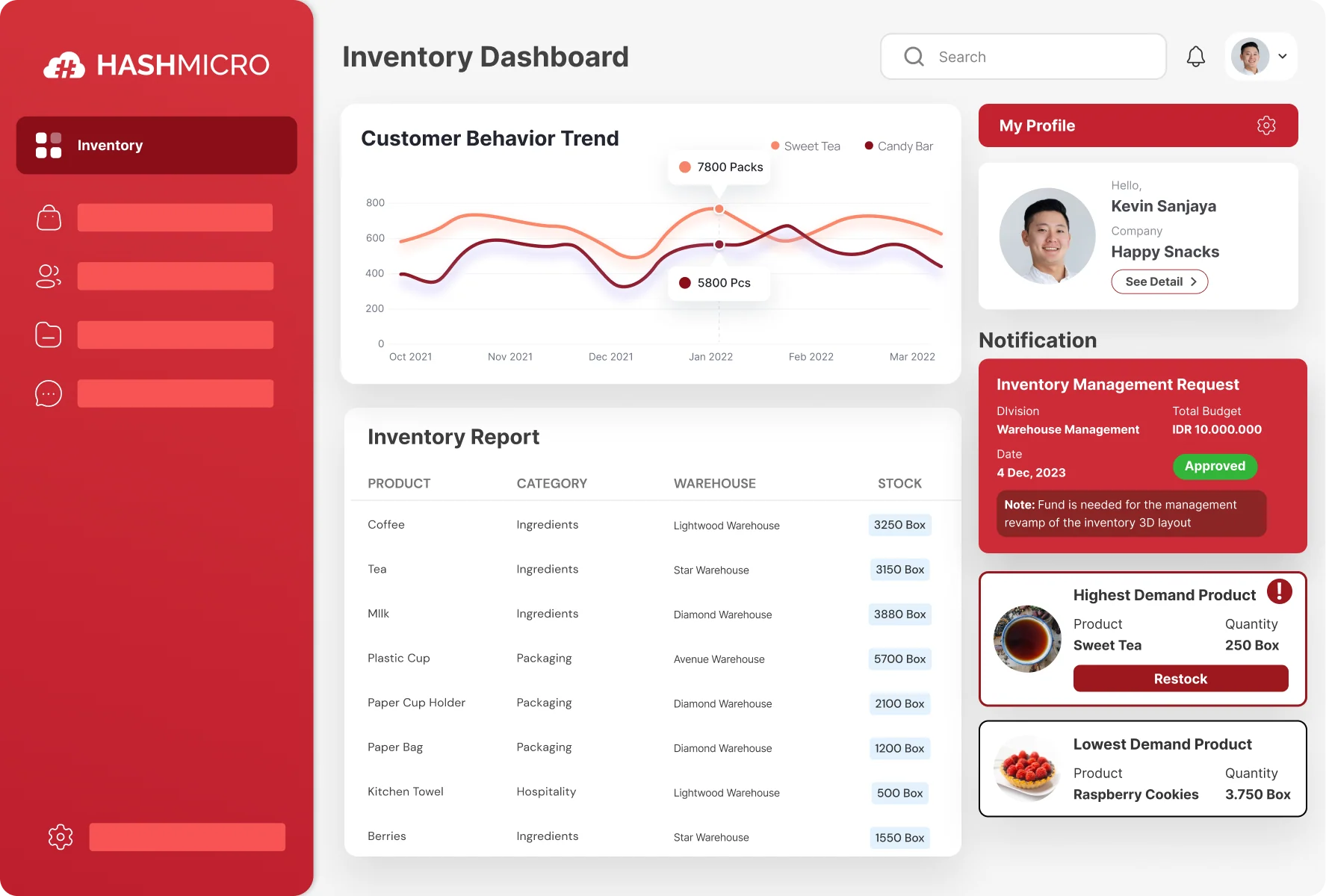Stockouts refer to when businesses run out of products or materials, disrupting orders and delaying deliveries. This shortage can lead to missed sales and unhappy customers, making stock management vital to running operations smoothly.
According to Statista, a 2020 survey in the Philippines found that SMEs with good inventory management delivered 52% of their output on time. Pero, kapag naubusan ng stock, when stock runs out, this percentage can drop, leading to delays and unmet customer demand due to unavailable products.
This article will explain the causes and effects of inventory stockouts and share strategies to avoid them. Additionally, we’ll explore how HashMicro’s inventory management software can help businesses manage stock levels and reduce the risk of stockouts.
Key Takeaways
|
Table of Contents

What is Inventory Stockout?
An inventory stockout occurs when a company runs out of a product and is unable to meet customer demand. This issue often arises due to poor inventory planning, inaccurate forecasts, or supply chain delays.
Stockouts can also result from late deliveries or production issues. This leads to customer dissatisfaction and missed sales opportunities. Retail and manufacturing businesses may face stockouts in the Philippines due to supply chain problems.
Although preventing stockouts is challenging, it’s not impossible. Companies can reduce them by improving inventory management and planning. Calculating the stockout rate helps businesses track shortages and adjust their stock levels accordingly.
Here is how you can calculate stockout rates:
Stockout Rate = (Number of Stockout Events / Total Demand Requests) x 100
To avoid stockouts, businesses need effective inventory management. These strategies include using early warning systems to detect low stock, accurate demand forecasting, and strong supplier relationships to ensure timely deliveries.
What Causes Inventory Stockouts?
Inventory stockouts can occur for various reasons within a company. Businesses must address these factors to prevent stock shortages and maintain efficiency.
Inefficient Inventory Management
Poor inventory management systems can cause stockouts. Without tracking stock in real-time, businesses lose inventory control, leading to problems managing warehouse stock. Companies without modern technology face even more challenges, which can lead to missed sales.
Supply Chain Disruptions
Another reason for stockouts is an inefficient or disrupted supply chain. If suppliers are unreliable or communication is poor, orders may be delayed, causing shortages of important materials. Good communication with suppliers is key to keeping things running smoothly.
Errors in Demand Forecasting
Incorrect demand forecasting is a major cause of stockouts. If a company underestimates customer demand, it won’t have enough stock. In the Philippines, unexpected demand increases from promotions can surprise businesses, leading to stock shortages and lost sales.
Poor Inter-Departmental Coordination
Lack of coordination between departments, like sales, marketing, and logistics, can cause stockouts. If the sales team doesn’t inform logistics of rising demand, inventory may not be replenished on time. Big promotions without enough stock planning can lead to unexpected shortages.
How Stockouts Affect Company Productivity
Stockouts can significantly harm a company’s productivity. One key effect is the damage to the company’s reputation. Customers lose trust when a business cannot provide timely products, reducing loyalty and long-term revenue.
Another impact is the disruption of production flow. Without necessary raw materials or semi-finished goods, production halts, orders are delayed, and operational efficiency is reduced. This often increases inventory cost as production takes longer to complete.
Stockouts also lead to inefficient time and resource management. Companies must scramble to find alternative suppliers or expedite deliveries, draining resources and lowering overall productivity.
The stockout cost to businesses can accumulate quickly through lost sales and increased operational expenses. Pero, huwag kang mag-alala! Next, let’s discuss how to prevent inventory stockouts for your business.
How to Prevent Inventory Stockouts
For a business owner, preventing stockouts is essential to maintaining customer satisfaction and operational efficiency. Below are 10 strategies to help avoid stockouts in your company:
1. Conduct Regular Stock Reviews
Regular stock audits can help companies identify items that are nearing depletion and take immediate action to reorder. In addition, stock reviews help identify slow-moving or irrelevant items, allowing companies to make informed decisions on their stock management.
2. Improve Customer Demand Forecasting
Accurate demand forecasting helps companies plan stock procurement more effectively. By using historical data, market trends, and customer input, businesses can make more precise predictions, reducing the risk of stockouts and better organizing production and delivery schedules.
3. Use an Effective Inventory Management System
Implementing an inventory management system can help companies monitor stock levels and send alerts when inventory falls below the minimum level. Systems like HashMicro Inventory Management offer comprehensive features, including real-time stock tracking and demand forecasting.
Click the banner below to explore HashMicro’s Inventory Software pricing and find the perfect solution for your business.
4. Use Safety Stock as a Backup
Safety stock is a buffer to handle sudden demand spikes or delivery delays. This method ensures that the production schedule continues without interruption, giving companies enough time to reorder stock and maintain productivity.
5. Determine the Right Reorder Point
Setting a proper reorder point ensures that companies reorder stock before it’s completely depleted. By considering supplier lead time, daily demand, and stock reserves, businesses can maintain optimal stock levels without overstocking.
6. Manage Products with the ABC Method
The ABC method categorizes products based on their value, helping companies focus on managing the most important items. By prioritizing high-value products, businesses can avoid stockouts while maintaining balanced stock levels for less crucial items.
7. Use Backup Suppliers
Having additional suppliers as a backup can prevent stockouts if the main supplier encounters issues. This method offers flexibility in pricing and delivery, ensuring consistent stock availability without depending solely on one supplier.
8. Implement a Just-in-Time (JIT) System
A JIT system minimizes the risk of overstock and stockouts by ordering goods only when needed. This inventory management strategy improves efficiency by reducing waste and ensuring that stock is replenished at the right time.
9. Implement an Early Warning System for Stockouts
An early warning system alerts companies when stock levels are low or potential supply chain issues exist. This system helps management act quickly, preventing stockouts and minimizing disruption to operations.
10. Improve Communication Between Departments
Clear communication between marketing, sales, and operations departments is key to avoiding stockouts. Sharing information about promotions or changes in strategy allows the inventory team to prepare and replenish stock in advance. This ensures smooth operations and prevents unexpected shortages.
Also read: What is the Bullwhip Effect? Understanding Its Role in Supply Chain Challenges
Preventing Stockouts with HashMicro’s Inventory System
Sa kabuuan, avoiding stockouts is a key goal for inventory management companies. Using HashMicro’s Inventory System can be a game-changer in ensuring that stock levels are well-maintained, minimizing the risk of stock shortages.
The HashMicro stock-out inventory system offers advanced features to prevent stockouts and lost sales. It even provides a free demo, allowing businesses to explore how the system can be tailored to their needs and improve stock management.
Key Features of HashMicro’s Inventory System:
- RFID Automation: Automates stock tracking in and out of warehouse racks, boosting efficiency and ensuring accurate inventory records.
- Stock Forecasting: Helps optimize inventory levels by predicting stock needs, improving customer satisfaction, and minimizing stockouts.
- Reordering Rules: Uses run rate data to reorder products based on trends, preventing overstock or stockouts by maintaining optimal stock levels.
- Stock Reservations & Reporting: This department ensures critical items are reserved and available when needed while improving inventory tracking and reporting accuracy.
- Warehouse Stock Optimizer: Maximizes warehouse space and improves efficiency in stock management by optimizing the arrangement and usage of warehouse stock.
Conclusion
Stockouts happen when a company runs out of stock, causing production delays and missed sales opportunities. This can hurt business operations and customer satisfaction, leading to lost revenue and damaged trust.
Kaya naman, to prevent this, using HashMicro’s Inventory Software is a smart solution. It provides powerful tools to manage stock levels, automate reordering, and predict demand, all through an easy-to-use interface.
Get a free demo today to see how HashMicro’s system can help your business avoid stockouts and improve inventory management!
Frequently Asked Questions About Inventory Stockout
-
What is safety stock?
Safety stock is extra inventory maintained to handle unpredictable demand and unexpected events.
-
What is out of stock?
Out-of-stock is when a store or company lacks a specific item, preventing customers from purchasing it.
-
What are examples of applications that can reduce potential stockouts?
HashMicro’s inventory system is an example of a tool you can utilize to minimize the risk of stockouts.
{
“@context”: “https://schema.org”,
“@type”: “FAQPage”,
“mainEntity”: [{
“@type”: “Question”,
“name”: “What is safety stock?”,
“acceptedAnswer”: {
“@type”: “Answer”,
“text”: “Safety stock is extra inventory maintained to handle unpredictable demand and unexpected events.”
}
},{
“@type”: “Question”,
“name”: “What is out of stock?”,
“acceptedAnswer”: {
“@type”: “Answer”,
“text”: “Out-of-stock is when a store or company lacks a specific item, preventing customers from purchasing it.”
}
},{
“@type”: “Question”,
“name”: “What are examples of applications that can reduce potential stockouts?”,
“acceptedAnswer”: {
“@type”: “Answer”,
“text”: “HashMicro’s inventory system is an example of a tool you can utilize to minimize the risk of stockouts.”
}
}]
}










































